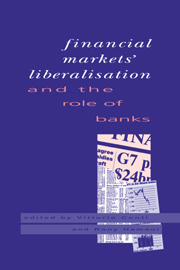Book contents
- Frontmatter
- Contents
- List of figures
- List of tables
- Preface
- Acknowledgements
- Notes on contributors
- Introduction
- PART I HOUSEHOLDS AND FIRMS
- 1 Marketable and non-marketable assets in households' portfolios: a cross-country comparison
- 2 Credit, money and consumption: time-series evidence for Italy
- Discussion
- 3 Empirical determinants of corporate debt decisions: some evidence for Italy
- Discussion
- PART II FINANCIAL MARKETS
- PART III BANKS
- Index
2 - Credit, money and consumption: time-series evidence for Italy
Published online by Cambridge University Press: 20 March 2010
- Frontmatter
- Contents
- List of figures
- List of tables
- Preface
- Acknowledgements
- Notes on contributors
- Introduction
- PART I HOUSEHOLDS AND FIRMS
- 1 Marketable and non-marketable assets in households' portfolios: a cross-country comparison
- 2 Credit, money and consumption: time-series evidence for Italy
- Discussion
- 3 Empirical determinants of corporate debt decisions: some evidence for Italy
- Discussion
- PART II FINANCIAL MARKETS
- PART III BANKS
- Index
Summary
Introduction
The main goal of this chapter is to study the implications of intertemporal maximising behaviour for consumption and interest rates in a world where credit markets are imperfect, and to provide some evidence from Italian macroeconomic time series. This is done by generalising the standard Euler equation approach of Hansen and Singleton (1982) to allow for the possibility of net wealth constraints and liquidity services provided by some of the assets available to the representative consumer.
When financial markets are perfect and agents are risk neutral expected rates of return should be equalised. Even if agents are risk averse, assets with similar risk should produce equal expected returns. Thus, if we consider two assets which are affected only by inflation risk we would expect identical returns. An example would be interest-bearing deposits and short-term bonds, as long as the risk of default by both the bank and the company issuing bonds was negligible. Yet, inspection of time-series returns on such assets reveals that bonds stochastically dominate deposits.
The simplest explanation for the (first order) stochastic dominance of short-term bonds over deposits is provided by the existence of transaction costs on the goods market. If goods can be purchased only with money, monetary assets provide liquidity services which are valuable to the consumer. In the extreme case where ‘cash in advance’ is required, the intertemporal optimisation problem facing individual consumers includes an additional inequality constraint (Lucas, 1982; Svensson, 1985).
- Type
- Chapter
- Information
- Financial Markets Liberalisation and the Role of Banks , pp. 36 - 51Publisher: Cambridge University PressPrint publication year: 1993

